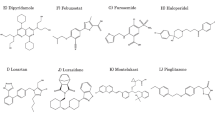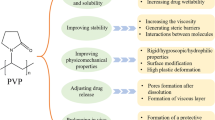Abstract
The objective of this study was to design oral controlled release matrix tablets of lamivudine using hydroxypropyl methylcellulose (HPMC) as the retardant polymer and to study the effect of various formulation factors such as polymer proportion, polymer viscosity, and compression force on the in vitro release of drug. In vitro release studies were performed using US Pharmacopeia type 1 apparatus (basket method) in 900 mL of pH 6.8 phosphate buffer at 100 rpm. The release kinetics were analyzed using the zero-order model equation, Higuchi’s square-root equation, and the Ritger-Peppas empirical equation. Compatibility of the drug with various excipients was studied. In vitro release studies revealed that the release rate decreased with increase in polymer proportion and viscosity grade. Increase in compression force was found to decrease the rate of drug release. Matrix tablets containing 60% HPMC 4000 cps were found to show good initial release (26% in first hour) and extended the release up to 16 hours. Matrix tablets containing 80% HPMC 4000 cps and 60% HPMC 15 000 cps showed a first-hour release of 22% but extended the release up to 20 hours. Methematical analysis of the release kinetics indicated that the nature of drug release from the matrix tablets was dependent on drug diffusion and polymer relaxation and therefore followed non-Fickian or anomalous release. No incompatibility was observed between the drug and excipients used in the formulation of matrix tablets. The developed controlled release matrix tablets of lamivudine, with good initial release (20%–25% in first hour) and extension of release up to 16 to 20 hours, can overcome the disadvantages of conventional tablets of lamivudine.
Similar content being viewed by others
References
Chien YW. Novel drug delivery systems. In: Chien YW, ed.Oral Drug Delivery and Delivery Systems. New York, NY: Marcel Dekker; 1992:139–196.
Vyas SP, Khar RK. Controlled drug delivery: concepts and advances. In: Vyas SP, Khar RK, eds.Controlled Oral Administration. Delhi, India: Vallabh Prakashan; 2002:155–195.
Joint United Nations Programme on HIV/AIDS (UNAIDS) and World Health Organization (WHO).AIDS Epidemic Update2005. Geneva, Switzerland: UNAIDS. Available at: http://www.unaids.org/epi/2005/doc/EPIupdate2005_pdf_en/epi-update2005_en.pdf. Accessed December 10, 2006.
Zhou J, Paton NI, Ditangco R, et al. Experience with the use of a first-line regimen of stavudine, lamivudine and nevirapine in patients in the TREAT Asia HIV Observational Database.HIV Med. 2007;8:8–16.
Castillo SA, Hernandez JE, Brothers CH. Long-term safety and tolerability of the lamivudine/abacavir combination as components of highly active antiretroviral therapy.Drug Saf. 2006;29:811–826.
Anthony SF, Clifford HL. Human immunodeficiency virus (HIV) disease: AIDS and related disorders. In: Braunwald E, Fauci AS, Kasper DL, Hauser SL, Longo DL, Jameson JL, eds.Harrison’s Principles of Internal Medicine. New York, NY: McGraw-Hill; 2001:1852–1913.
Betty JD. Human immunodeficiency virus (HIV)—antiretroviral therapy. In: Herfindal ET, Gourley DR, eds.Textbook of Therapeutics: Drug and Disease Management. Philadelphia, PA: Lippincott Williams & Wilkins; 2000:1555–1582.
Moyle G. Clinical manifestations and management of antiretroviral nucleoside analog-related mitochondrial toxicity.Clin Ther. 2000;22:911–936.
Vargas CI, Ghaly ES. Kinetic release of theophylline from hydrophilic swellable matrices.Drug Dev Ind Pharm. 1999;25:1045–1050.
Ranga RKV, Padmalatha DK, Buri B. Cellulose matrices for zero-order release of soluble drugs.Drug Dev Ind Pharm. 1988;14:2299–2320.
Parojcic J, Duric Z, Jovanovic M, Ibric S. An investigation into the factors influencing drug release from hydrophilic matrix tablets based on novel carbomer polymers.Drug Deliv. 2004;11:59–65.
Korsenmeyer RW, Peppas NA. Macromolecular and modeling aspects of swelling-controlled systems. In: Mansdorf SZ, Roseman TJ, eds.Controlled Release Delivery Systems. New York, NY: Marcel Dekker; 1983:77.
Bravo SA, Lamas MC, Salomon CJ. Swellable matrices for the controlled-release of diclofenac sodium: formulation and in vitro studies.Pharm Dev Technol. 2004;9:75–83.
Velasco MV, Ford JL, Rowe P, Rajabi-Siahboomi AR. Influence of drug:hydroxypropyl methylcellulose ratio, drug and polymer particle size and compression force on the release of diclofenac sodium from HPMC matrices.J Control Release. 1999;57:75–85.
Heng PWS, Chan LW, Easterbrook MG, Li X. Investigation of the influence of mean HPMC particle size and number of polymer particles on the release of aspirin from swellable hydrophilic matrix tablets.J Control Release. 2001;76:39–49.
Lee BJ, Ryu SG, Cui JH. Formulation and release characteristics of hydroxypropyl methylcellulose matrix tablet containing melatonin.Drug Dev Ind Pharm. 1999;25:493–501.
Katzhendler I, Mader K, Friedman M. Structure and hydration properties of hydroxypropyl methylcellulose matrices containing naproxen and naproxen sodium.Int J Pharm. 2000;200:161–179.
Tapia-Albarran M, Villafuerte-Robles L. Effect of formulation and process variables on the release behavior of amoxicillin matrix tablets.Drug Dev Ind Pharm. 2004;30:901–908.
Narasimhan B, Peppas NA. Disentanglement and repetition during dissolution of rubbery polymers.J Polym Sci Part B: Polym Phys. 1996;34:947–961.
Narasimhan B, Peppas NA. Molecular analysis of drug delivery systems controlled by dissolution of the polymer carrier.J Pharm Sci. 1997;86:297–304.
Vazquez MJ, Perez-Marcos B, Gomez-Amoza JL, Martinez-Pacheco R, Souto C, Concheiro A. Influence of technological variables on release of drugs from hydrophilic matrices.Drug Dev Ind Pharm. 1992;8:1355–1375.
Li S, Shen Y, Li W, Hao X. A common profile for polymer-based controlled release and its logical interpretation to general release process.J Pharm Pharm Sci. 2006;9:238–244.
Ritger PL, Peppas NA. A simple equation for the description of solute release, II: Fickian and anomalous release from swellable devices.J Control Release. 1987;5:37–42.
Kuksal A, Tiwary AK, Jain NK, Jain S. Formulation and in vitro, in vivo evaluation of extended-release matrix tablet of zidovudine: influence of combination of hydrophilic and hydrophobic matrix formers.AAPS PharmSciTech [serial online]. 2006;7:E1.
Al-Taani BM, Tashtoush BM. Effect of microenvironment pH of swellable and erodable buffered matrices on the release characteristics of diclofenac sodium.AAPS PharmSciTech [serial online]. 2003;4:E43.
Costa P, Lobo JMS. Modeling and comparison of dissolution profiles.Eur J Pharm Sci. 2001;13:123–133.
Ford JL, Rubinstein MH, Hogan JE. Formulation of sustained release promethazine hydrochloride tablets using hydroxypropyl methylcellulose matrices.Int J Pharm. 1985;24:327–338.
Ford JL, Rubinstein MH, Hogan JE. Propranolol hydrochloride and aminophylline release from matrix tablets containing hydroxypropyl methylcellulose.Int J Pharm. 1985;24:339–350.
Ford JL, Rubinstein MH, Hogan JE. Dissolution of a poorly water soluble drug, indomethacin, from hydroxypropyl methylcellulose controlled release tablets.J Pharm Pharmacol. 1985;37:33P.
Shah N, Zhang G, Apelian V, Zeng F, Infeld MH, Malick AW. Prediction of drug release from hydroxypropyl methylcellulose (HPMC) matrices: effect of polymer concentration.Pharm Res. 1993;10:1693–1695.
Kim H, Fassihi R. Application of binary polymer system in drug release rate modulation, 2: influence of formulation variables and hydrodynamic conditions on release kinetics.J Pharm Sci. 1997;86:323–328.
Dahl TC, Calderwood T, Bormeth A, Trimble K, Piepmeir E. Influence of physico-chemical properties of hydroxypropyl methylcellulose in naproxen release from sustained release matrix tablets.J Control Release. 1990;14:1–10.
Liu CH, Kao Y, Chen S, Sokoloski TD, Sheu MT. In-vitro and in-vivo studies of the diclofenac sodium controlled release matrix tablets.J Pharm Pharmacol. 1995;47:360–364.
Hiremath SP, Saha RN. Design and study of rifampicin oral controlled release formulations.Drug Deliv. 2004;11:311–317.
York P. A consideration of experimental variables in the analysis of powder compaction behavior.J Pharm Pharmacol. 1979;31:244–246.
Author information
Authors and Affiliations
Corresponding author
Additional information
Themed Issue: Oral Controlled Release Development and Technology
Guest Editor — Stephen A. Howard and Jian-Xin Li
Published: December 7, 2007
Rights and permissions
About this article
Cite this article
Ravi, P.R., Ganga, S. & Saha, R.N. Design and study of lamivudine oral controlled release tablets. AAPS PharmSciTech 8, 101 (2007). https://doi.org/10.1208/pt0804101
Received:
Revised:
Accepted:
DOI: https://doi.org/10.1208/pt0804101




